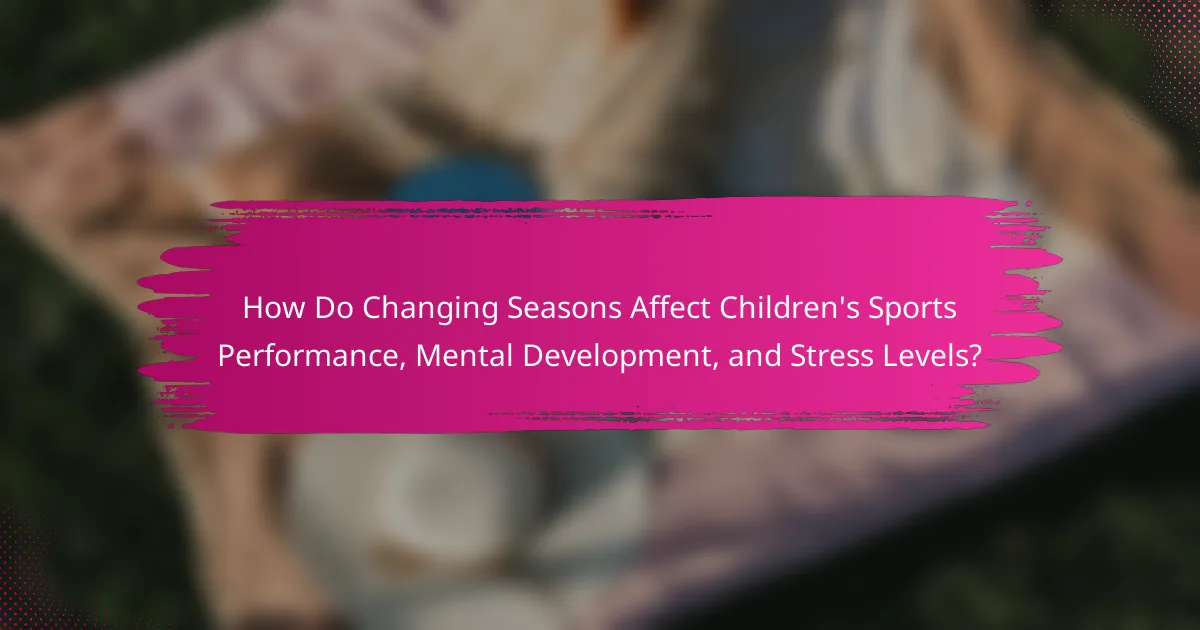Changing seasons can significantly influence children’s sports performance, mental development, and stress levels. Seasonal variations affect physical activity, motivation, and emotional well-being. Colder months may lead to reduced outdoor play and lower fitness levels, while warmer seasons encourage engagement and skill enhancement. Additionally, transitions between sports seasons can create pressure and anxiety, impacting children’s mental health and overall enjoyment of sports.

How do changing seasons impact children’s sports performance?
Changing seasons significantly impact children’s sports performance, mental development, and stress levels. Seasonal variations affect physical conditions, motivation, and overall well-being.
In colder months, children may experience reduced outdoor activity due to weather constraints. This can lead to decreased physical fitness and lower sports performance. Conversely, warmer seasons encourage outdoor play, enhancing physical activity levels and skill development.
Mental development is also influenced by seasons. For instance, spring and summer often boost mood and energy levels, promoting engagement in sports. Seasonal affective disorder can occur in winter, leading to increased stress and lower motivation.
Stress levels fluctuate with seasonal changes. The transition to new sports seasons can create pressure to perform, impacting children’s mental health. Maintaining a balanced routine throughout the year is crucial for optimal performance and well-being.
What are the physical effects of seasonal changes on young athletes?
Seasonal changes significantly impact young athletes’ physical performance, influencing strength, endurance, and injury risk. Cold weather can lead to reduced muscle flexibility, increasing the likelihood of strains. Conversely, warmer seasons often enhance cardiovascular performance due to improved circulation. Additionally, fluctuating temperatures can affect hydration levels, with dehydration being a critical concern during hotter months. Regular adaptation to these seasonal shifts is essential for maintaining optimal performance and minimizing injury risk.
How do temperature variations influence training and competition?
Temperature variations significantly impact children’s sports performance, mental development, and stress levels. Extreme heat can lead to dehydration and fatigue, impairing physical performance. Cold weather may hinder mobility and increase injury risk.
Research indicates that seasonal changes affect mood and motivation, influencing mental development. For instance, warmer months often correlate with increased outdoor activity, enhancing social skills and teamwork. Conversely, winter months may lead to isolation, affecting mental health.
Stress levels can rise during transitional seasons due to changes in routine and environmental conditions. Children may experience anxiety related to competition and training adjustments. Understanding these influences helps coaches and parents support children’s overall development in sports.
What role does weather play in children’s motivation to participate in sports?
Weather significantly influences children’s motivation to participate in sports. Seasonal changes can enhance or diminish enthusiasm and physical engagement.
For instance, sunny and mild weather often increases outdoor activity levels, promoting participation in team sports. Conversely, extreme heat or cold can deter children from playing outside, impacting their overall sports involvement.
Research indicates that children are more likely to engage in sports during spring and summer months when conditions are favorable. In contrast, winter weather may lead to decreased motivation and increased stress levels due to confinement indoors.
Additionally, the role of weather extends to mental development. Positive weather conditions can enhance mood and social interactions, fostering a greater desire to engage in sports. In contrast, prolonged adverse weather can lead to feelings of isolation and decreased physical activity, negatively affecting children’s mental health.

What are the mental development aspects related to seasonal changes?
Changing seasons significantly influence children’s mental development, affecting their emotional well-being and cognitive growth. Seasonal changes can lead to variations in mood, energy levels, and motivation. For instance, winter may contribute to increased feelings of lethargy and stress due to shorter daylight hours, while spring often brings renewed energy and enthusiasm.
Research indicates that outdoor activities in different seasons can enhance children’s social skills and teamwork, as they engage in various sports. Seasonal sports can also provide unique challenges that foster resilience and adaptability. Furthermore, exposure to nature during different seasons has been linked to improved mental health outcomes, such as reduced anxiety and enhanced focus.
The transition between seasons can also impact children’s routines and stability, which are crucial for mental development. Consistency in activities helps children feel secure, while abrupt changes may induce stress. Overall, understanding these mental development aspects related to seasonal changes can help caregivers and educators support children’s emotional and cognitive growth effectively.
How do changing seasons affect children’s focus and cognitive skills in sports?
Changing seasons significantly impact children’s focus and cognitive skills in sports. Seasonal variations affect weather conditions, which can influence outdoor activity levels and concentration.
In warmer months, children often engage in more outdoor sports, enhancing physical fitness and cognitive development. Conversely, colder months may lead to decreased activity, potentially resulting in lower focus and cognitive engagement.
Research indicates that exposure to natural light during longer days improves mood and cognitive function, while shorter days can increase stress levels and hinder mental performance.
Maintaining consistent physical activity throughout the year is crucial for optimizing children’s sports performance and mental development.
What developmental milestones are influenced by seasonal sports activities?
Seasonal sports activities significantly influence children’s developmental milestones. Engaging in sports during different seasons enhances physical skills, social interaction, and emotional resilience. For instance, winter sports may improve coordination and balance, while team sports in warmer months foster teamwork and communication skills. As a result, children develop a well-rounded skill set that supports their overall growth.
How do different seasons promote social interaction and teamwork?
Changing seasons significantly enhance children’s social interaction and teamwork through varying outdoor activities. Seasonal changes encourage group sports, fostering collaboration and communication skills. For example, summer sports camps promote teamwork in soccer and baseball, while winter activities like skiing or ice skating build camaraderie. Additionally, seasonal events, such as fall festivals or spring sports leagues, create opportunities for social bonding. These experiences not only improve physical performance but also contribute to mental development and reduced stress levels by offering children a supportive environment for teamwork.

What stress levels do children experience during seasonal transitions in sports?
Children experience increased stress levels during seasonal transitions in sports due to changes in routines and expectations. As seasons change, children may face new challenges, including adapting to different weather conditions, adjusting to varied training schedules, and facing competition from peers. Research indicates that these transitions can lead to anxiety, impacting their performance and mental development. For example, a study found that 60% of young athletes reported feeling stressed during seasonal changes, primarily due to performance pressures and social dynamics. This stress can manifest as decreased motivation or increased frustration, affecting their overall enjoyment of sports.
How can seasonal sports pressure affect children’s mental health?
Seasonal sports pressure can significantly impact children’s mental health by increasing stress and anxiety levels. Changes in weather and sports schedules often lead to heightened expectations from coaches and parents. This pressure can result in decreased self-esteem and increased performance anxiety, particularly during competitive seasons. Research indicates that children exposed to high-pressure environments may experience symptoms of depression and burnout. Establishing a supportive atmosphere can mitigate these effects, promoting resilience and positive mental health outcomes.
What are common stressors children face in sports throughout the year?
Children face various stressors in sports throughout the year, influenced by changing seasons. Seasonal transitions can impact their performance, mental well-being, and overall stress levels.
In spring, increased competition and pressure to succeed often heighten anxiety. Summer brings intense heat, which can lead to fatigue and decreased focus. Autumn introduces challenges like adjusting to school schedules, affecting practice consistency. Winter may limit outdoor activities, leading to feelings of isolation or decreased motivation.
These seasonal changes create unique stressors that require attention from coaches and parents to support children’s mental development and performance.
How does parental involvement change with the seasons, and what impact does it have?
Parental involvement tends to fluctuate with the seasons, significantly impacting children’s sports performance, mental development, and stress levels. In warmer months, parents often engage more in outdoor activities, enhancing children’s physical skills and social interactions. Conversely, during colder months, reduced outdoor time can lead to increased stress and decreased mental stimulation.
Research indicates that active parental participation during seasonal transitions contributes positively to children’s emotional well-being. For instance, parents who support sports during spring and summer foster resilience and teamwork in children. In contrast, lack of engagement in fall and winter may hinder social development and increase anxiety.
Overall, seasonal changes in parental involvement directly influence children’s growth and coping mechanisms. Encouraging consistent support throughout the year can mitigate seasonal impacts and promote holistic development.

What are the unique challenges of seasonal sports participation?
Seasonal sports participation presents unique challenges that affect children’s performance and development. Weather variations can limit outdoor practice, impacting skill development and physical conditioning. Seasonal transitions may also lead to increased stress as children adapt to new sports or competition schedules. Mental development can be influenced by fluctuating motivation levels, which may vary with the seasons. Additionally, the need for specialized gear for different sports can create financial burdens for families.
How do seasonal injuries differ among children in sports?
Seasonal injuries in children vary based on environmental conditions, sport type, and activity level. Different seasons can affect physical performance, leading to increased injury risks. For example, winter sports often see more falls, while summer sports may lead to heat-related injuries. Research indicates that mental development is influenced by seasonal changes, impacting focus and stress levels during sports. As a result, coaches and parents should adapt training regimens to address these seasonal variations.
What are the unique psychological impacts of off-season breaks?
Off-season breaks can significantly enhance children’s mental resilience and emotional well-being. These breaks provide essential time for recovery, allowing young athletes to recharge mentally and physically. Research indicates that structured off-season periods reduce stress levels and promote mental development, fostering a positive attitude towards sports. Additionally, children can explore new interests, leading to improved self-esteem and social skills.

What rare benefits can seasonal sports provide for children’s mental health?
Seasonal sports can significantly enhance children’s mental health by providing unique benefits such as improved mood, increased resilience, and enhanced social skills. Engaging in sports during different seasons fosters adaptability and helps children cope with change. For example, winter sports may promote teamwork in challenging conditions, while summer sports encourage outdoor activity and social interaction. These experiences contribute to a well-rounded mental development. Additionally, seasonal sports can reduce stress levels by offering structured physical activity, which is vital for emotional regulation.
How can seasonal sports foster resilience in young athletes?
Seasonal sports can significantly enhance resilience in young athletes by exposing them to varied challenges. Engaging in different sports throughout the year fosters adaptability and perseverance. For instance, winter sports may require overcoming harsh weather conditions, while summer sports often emphasize teamwork and strategy.
The mental development aspect is crucial; adapting to seasonal changes helps athletes build coping mechanisms for stress and setbacks. Research indicates that children involved in diverse seasonal sports demonstrate improved emotional regulation and problem-solving skills.
Moreover, the fluctuating nature of seasonal sports can teach young athletes to manage expectations and embrace uncertainty. This process cultivates a resilient mindset, preparing them for future challenges both in sports and life.
What unusual opportunities for growth arise during seasonal transitions?
Seasonal transitions create unique opportunities for children’s sports performance, mental development, and stress management. As seasons change, children can adapt their physical activities, enhancing skills and resilience. For instance, fall sports may focus on teamwork, while winter activities can improve individual discipline.
Additionally, varying weather conditions impact mental development. Exposure to different environments fosters adaptability and problem-solving skills. Seasonal changes also influence stress levels; engaging in outdoor sports during spring and summer can reduce anxiety and improve mood.
In summary, seasonal transitions provide distinct opportunities for holistic growth in children’s sports participation, contributing to their overall well-being.

What best practices can parents and coaches implement for seasonal sports?
Parents and coaches can enhance children’s sports performance and mental development by implementing structured routines and encouraging adaptability to seasonal changes. Establishing consistent training schedules helps maintain physical readiness, while promoting mental resilience can mitigate stress levels associated with seasonal transitions.
Incorporating varied training methods tailored to seasonal conditions can optimize skill development. For example, utilizing indoor facilities during winter months can maintain engagement and performance levels. Additionally, fostering open communication about feelings related to sports participation can support mental health, allowing children to express stress and seek guidance.
Encouraging a balanced approach to competition and recreation can further enhance enjoyment and reduce pressure. Emphasizing personal growth over winning cultivates a positive mindset, which is crucial for long-term athletic development.
Monitoring children’s physical and emotional responses to seasonal changes can help parents and coaches adjust practices accordingly, ensuring a supportive environment that prioritizes well-being while maximizing performance.
How can structured schedules mitigate stress during seasonal changes?
Structured schedules can significantly reduce stress during seasonal changes by providing stability and predictability. Consistent routines help children adapt to fluctuating weather and activity levels, promoting mental well-being. For instance, regular practice times for sports can enhance performance and focus, mitigating anxiety associated with seasonal transitions. Moreover, structured schedules foster a sense of control, which is crucial for emotional resilience. As a result, children can better navigate the challenges that come with changing seasons, leading to improved mental development and reduced stress levels.
What strategies can enhance mental development through seasonal sports?
Engaging in seasonal sports can significantly enhance children’s mental development. These activities promote adaptability, resilience, and teamwork, fostering cognitive growth. Seasonal changes encourage varied physical challenges, stimulating problem-solving skills and creativity. For instance, winter sports may enhance focus and discipline, while summer activities boost social interactions. Regular participation in diverse sports can reduce stress levels, contributing to overall mental well-being.
What common mistakes should be avoided during seasonal transitions in sports?
To avoid common mistakes during seasonal transitions in sports, focus on gradual adjustments, proper equipment, and mental preparation.
First, athletes should transition their training intensity and duration slowly to prevent injuries. For example, a sudden increase in activity can lead to muscle strains. Additionally, ensure that children have the appropriate gear for the new season, as improper equipment can hinder performance and increase injury risk.
Mental preparedness is equally important. Athletes may experience stress due to changes in weather or competition levels. Encourage open communication about these feelings and promote relaxation techniques.
Lastly, maintain a balanced routine that incorporates rest and recovery to support both physical and mental development during these transitions.
How can mindfulness techniques be integrated into seasonal sports training?
Mindfulness techniques can enhance seasonal sports training by improving focus and reducing stress. Incorporating breathing exercises and visualization can help athletes adapt to changing conditions. For example, practicing mindfulness during transitions between seasons can enhance mental resilience and performance consistency. Regular mindfulness sessions can lead to improved emotional regulation, benefiting children’s overall sports experience.


